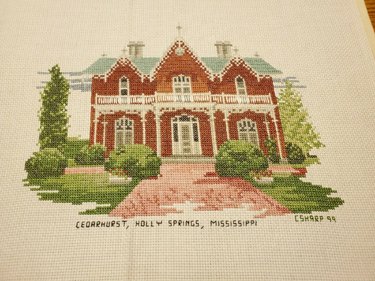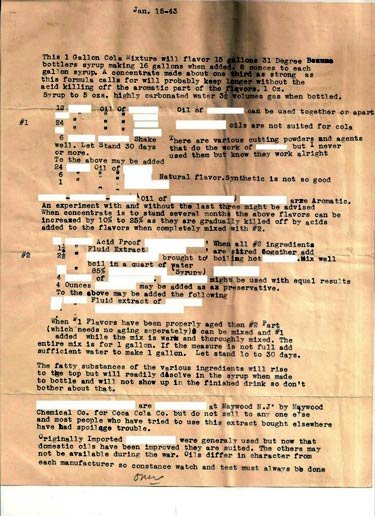Category Archive 'Ebay'
16 Sep 2021


Two locks of hair, one blond, one brown, allegedly from the head of Emily Dickinson are being offered for sale on Ebay for $450,000.
Were they stolen decades ago from The Evergreens by the poet James Merrill? See LithHub.
[A] bit of questionably obtained Dickinson memorabilia has been quietly traded among a group of literary men for years: locks alleged to be the poet’s hair (some of which are now for sale on eBay for the astronomical sum of $450,000).
How the poet—who chose to cloister her living body from all but a few visitors—would feel about pieces of it making the rounds is anybody’s guess. The dead cannot give consent. But the alleged Dickinson hair may have arrived on the market by a type of violation: theft. That’s the theory of Mark Gallagher, the English faculty member at UCLA who’s trying to sell the hair on eBay.
The story goes like this: While an undergraduate at Amherst College in the 1940s, Pulitzer Prize-winning poet James Merrill broke into the home (aka The Evergreens) of Dickinson’s niece, Martha Dickinson Bianchi. Merrill and two friends absconded with personal effects, including a small mirror, “tiny wine glass,” and a manuscript sheet—written by whom, it is unclear. The caper was recounted by Stephen Yenser in a 1995 issue of Poetry magazine dedicated to Merrill, who had died earlier that year. Yenser, Merrill’s literary executor and the now-retired founder of UCLA’s creative writing program, said he heard the tale from Merrill himself. In Poetry, he euphemized what was essentially burglary with terms like “borrowed” and “rescued,” writing that the trio “gained clandestine entry.”
The anecdote has been whispered among Dickinson scholars for years, according to University of Maryland English Prof. Martha Nell Smith, one of the nation’s foremost experts on Dickinson.
“I’ve long been convinced James Merrill did wander off with (steal?) some Dickinson items from the Evergreens, Martha Dickinson Bianchi’s home,” Smith wrote in an email.
Gallagher believes that Merrill must have also taken the hair during the alleged break-in at The Evergreens. Gallagher got his hands on the hair by way of the poet J.D. McClatchy, who, until his death in 2018, shared Merrill’s literary executorship with Yenser. McClatchy’s estate sale, where Gallagher purchased the hair, listed Merrill as the original owner.
Yenser, for his part, denies any nefarious origin for the locks. He says the hair came from an envelope found inside an 1890 edition of Poems by Emily Dickinson that belonged to Merrill, likely purchased from a rare book dealer.
Yet the envelope was labeled in cursive “For Mrs. Dickinson,” and the book in which it was found includes notes from Susan Gilbert Dickinson, according to Yale University, which now holds the volume and provided photos of the artifacts (below). Susan was Martha’s mother, and she and her husband Austin, Emily’s brother, lived at The Evergreens until their respective deaths in 1895 and 1913. Their daughter Martha then moved into the property and “preserved it without change, until her own death in 1943,” according to the Emily Dickinson Museum in Amherst, which controls The Evergreens. As far as Gallagher is concerned it’s quite possible Merrill took the book when he broke into the property.
RTWT
11 Jul 2021

I found this completed needlepoint project, depicting “Cedarhurst,” our recently-acquired Deep South retirement house, on Ebay.
The same seller is offering another of these depicting “Walter Place.”
Holly Springs, despite being a small town of 7000 souls, has over sixty surviving Antebellum mansions, and evidently, back in the 1990s, some needlepoint firm was selling canvases featuring a number of its more notable houses.
I am naturally impressed with myself for owning a house that people portray in needlework.
25 Jun 2015

I sent this email this morning to Amazon PR:
If you look at my account, you will see that I am a very active Amazon customer. Additionally, I had been linking Amazon books via my blog and am an Amazon Associate.
In response to Amazon’s absurd removal of Confederate flag-related merchandise in contemptible obedience to the whims of the radical left, I will be removing my blog links to Amazon and purchasing absolutely nothing from Amazon for one month.
Deo Vindice,
David Zincavage
I’m sending a similar email to Ebay, where I am also a very active customer. I don’t actually shop at KMart or Walmart, and I mean to make a point of continuing not to do so.
08 Mar 2015


Texas Loadmaster Loading Press
I used to reload ammunition, decades ago, when I was young and poor and keen. Like many people, over the years I became busier and more prosperous. I never reloaded anything, and I finally gave away all my tools and supplies. Farewell, Herter’s powder measure and scale and Pacific press!
I got outbid back in the 1980s, in the auction of John Amber’s gun collection, for a Krag customized by A.O. Neidner, and I’ve had a hankering for a Neidner custom rifle ever since.
Last Fall, I ran into a Neidner-built Mauser with a special barrel by the legendary old-time Tucson barrel-maker Bill Sukalle on Gun Broker. It was of unknown chambering, but it was a Neidner with extra Sukalle on the side, so I just had to buy it.
Of course, it turned out that the rifle had been made before 1930 and chambered in a wildcat cartridge invented by Major Ned Roberts, the .25 Roberts, that was modified slightly* and commercialized by Remington in 1934 as the .257 Roberts.
So I’ve been studying on how to modify 7×57 Mauser brass and gradually picking up loading tools and supplies in order to feed that Neidner rifle.
My acquisition agenda has me looking at used loading tools on Ebay, and (as everybody knows) Ebay thoughtfully arranges for items similar to those you have been looking at to pop up to tempt you.
Recently, via that Ebay policy, I came across the strangest thing.
—————————————————
It was Ebay item number 121584408509 (this link will only function for for so many weeks, until Ebay gets rid of the expired listing).
Here is a restored Texan loadmaster turret reloading press. This is circa early 1960’s and in excellent overall condition. The shafts have been re-blued as has the top turret cap by Turnbull restoration and the turret has been color case hardened. The main driving tumbler has also been re-blued and the body has been sand blasted and re-painted with VHT wrinkle paint to simulate the original finish. The decal too is a new reproduction that is smaller than the originals. Finally, the handle has been turned out of stainless steel as the originals were prone to bending. It does NOT come with the priming system normally available with these. It also has no shell holders and only one priming arm. This was rebuilt to reload – or you can just sit there and look at it. It’s up to you. No international shipping – and no returns.
—————————————————
Ebay shoved in front of my nose a massive old turreted loading press from the 1960s by a completely unheard of manufacturer. I used to load when I was in high school in the 1960s, so I’m basically familiar with the standard companies which made loading gear, Lyman and Lee, Reddding and RCBS, Hornaday, Pacific and Herter’s (both now gone). But I never heard of a Texas Loadmaster.
The bid was already up to $214.50, with a few days to go, which I thought extraordinary for an ancient 1960s model loading press. You can buy brand-new top end turret presses all day for that kind of money.
But what was really bizarre was the seller’s statement that this press had been painstakingly restored by Turnbull Restoration. Turnbull Restoration, of course, is a really high-end company, renowned for their unequaled case hardening, which produces extremely beautiful and extremely expensive replica Winchester Model 1886s and Colt 1911s.
What could possibly have possessed somebody to ship off some obscure 1960s loading press to Turnbull for a top-quality restoration? That kind of work by Turnbull undoubtedly costs roughly all the tea in China. For what that must have cost you could buy a large pile of brand-new, 50-years-improved current presses and still have change for a beer.
I was tempted to bid on it. The winner would obviously be getting thousands of dollars of restoration work for some hundreds of dollars, but… When I Googled “Texas Loadmaster”, I couldn’t find anything. All that came up was a new “Loadmaster” press by Lee. I had to search under “Sovereign Instruments Texas Loadmaster”, and I still found only minimal information.
Upon reflection, I concluded that this press was certainly missing parts. I felt sure I could never locate a manual or any parts for it, so what would I do if it needed special shell holders or die bushings?
Bidding ended where it was yesterday, at $214.50. Did someone get the bargain of the century? I doubt it, but who knows?
Anyway, I thought I would write all this up, and throw the mystery out there. The Internet being what it is, you never know. Somebody may come along who can supply the answer to the question of why would anyone restore that press?
*Remington saved work by skipping the original shortening of the 7×57 Mauser case by 1/16″, moved forward the shoulder angle and changed the angle from 15 degrees to a sharper 20 degrees.

Sovereign Instruments, Dallas decal
11 Nov 2014


Ebay lot 381041066398 was sitting there at $230.00 on Saturday as the auction drew toward its close at 8:27 pm. I had just bought a rifle on Gun Broker, so I was feeling a need for some restraint, but I certainly was not going to let this sell for $230.00 without bidding a bit higher. So I left an Esnipe bid somewhere near $300.
It’s impossible to tell what some auctions are going to do in their final moments, when all the snipers open fire. You can bid double the current bid sometimes and still find that you came in too low. I had no idea what this dagger would fetch. It was obviously worth a great deal more than $230, but beyond that I hadn’t a clue.
It sold, as things turned out, for $599.90, and I still think it was worth much more than that.
————————-
The seller described it as an “Old antique Italian Hunting knife/dagger SUPER NICE RARE.”
You are bidding on an antique Italian hunting knife. This is an exceptional example well made and well preserved. It probably dates from the first half of the 19th century. It is large 15-1/2 inches long, solid blade 11 inches long with two decorative fullers and mirror engraved images as well as a small section of brass inlay, the blade is 2 inches wide at the base. The handle is made from wood with two decorative brass side grips and a very interesting tang section that can be seen on the back. Nice file work on the mid section. Super nice knife.
But, what was it really?
I looked through George Cameron Stone’s A Glossary of the Construction, Decoration and Use of Arms and Armor in All Countries and in All Times, Together with Some Closely Related Subjects, and my conclusion is that it was an anelace aka anelec aka anlace, a long dagger variation of the cinquedea featuring a triangular double-edged blade tapering sharply to a point: used from the 13th to the 16th centuries. This weapon was often carried at an angle at the small of the back and would be the only weapon carried in cities, at court, traveling on horseback or riding during the hunt, also used to slide between the plates of platemail armour.
It does not look old enough to me to be 16th century. It has an 18th century look to me. But, I suppose, it might have been an extremely high quality 19th century reproduction.
12 Feb 2014


It seems that, either on land in Gaza or under the sea nearby, last summer, some ignorant and greedy barbarians came into possession of an unusually intact and highly artistically significant Hellenistic bronze statue of Apollo. Reports differ, but apparently the priceless statue was briefly being offered on Ebay for $500,000, probably only a fraction of its actual value. Its finder, we are told, chopped off a few fingers for testing, thinking that the statue might be gold. Police representing the Palestinian authority, Hamas, subsequently seized the statue, and it has disappeared.
We can only hope that the nearby civilized state of Israel will take steps to secure possession of this important art object on behalf of the rest of the nations of the West.
Businessweek, January 30th: The Apollo of Gaza: Hamas’s Ancient Bronze Statue
The Guardian, February 10th: ‘Priceless’ bronze statue of Greek god Apollo found in Gaza Strip — Hamas officials seize statue after it appears on eBay — Doubt cast on fisherman’s claim to have found item in sea
Businessweek, February 10th: New Details Emerge in Mystery of Bronze Apollo Held by Hamas
The Verge, February 11th: Ancient statue of Greek god Apollo discovered in Gaza strip
Hat tip to Karen L. Myers.
19 May 2013


Time, May 14:
A Georgia antiques collector is the latest person to claim that he might have found the original recipe for Coca-Cola.
Cliff Kluge and his wife Arlene recently bought a box of letters at an estate sale, and one of the yellowed papers, dated 1943, includes instructions for making cola, according to Atlanta’s WXIA. Kluge thinks it could potentially be the recipe for Coca-Cola and is trying to sell it on eBay; bidding starts at $5 million, but customers can buy it now for $15 million.
———————————————–
Somebody clearly believed that it was real, as it Sold via “Buy It Now” on May 15th:
On May 8th, 1886, Dr. John Stythe Pemberton, a pharmacist and inventor of medicinal beverages, invented the world’s most famous drink – Coca Cola. Shortly after, he began selling the fountain drink in a nearby Atlanta pharmacy. Concocted in a brass kettle in his back yard, this patent medicine was billed as being able to cure anything from morphine addiction to headaches to impotence.The ingredients, their ratio and the process method of the beverage is one ofthe most closely guarded secrets in the world. To this day, it is said that only two of Coca Cola’s executives know the entire ingredients.
In 1899, Benjamin F. Thomas and Joseph B. Whitehead of Chattanooga, met with Asa Chandler, then President and owner of the Coca Cola Company. They approached him with the idea of bottling the beverage. Until then, Coca Cola was only available as a fountain drink. After much negotiations, Mr. Chandler agreed to grant bottling rights to the two gentleman, for the astronomical fee of $1.00.(He never collected the $1.00, by the way) Thus born was the world’s first Coca Cola Bottling Company, located in Chattanooga, Tennessee.
Fast forward 100+ years later to the 21st Century – we were at an estate sale of a deceased, renown Chattanooga chemist, who at one time worked at one of the more prominent chemical companies in the area. There were masses upon masses of personal paperwork at the sale. Curious, we bought several boxes of this paperwork, which yielded some interesting finds. Among those finds is what is offered for sale here – what we believe to be the formula for Coca Cola.
Typed on January 15th, 1943, this single page (front and back) breaks down the formula into exact amounts of specific ingredients to make one gallon of concentrate, which, when combined and processed yields enough to make 16 gallons..
May we make this perfectly clear – we can never guarantee and never claim that this is the actual recipe for Coca Cola. Even if this formula was 100% accurate in every aspect– as mentioned above– there are only two people in the world that can verify it’s accuracy, and I doubt they will be willing to compromise Coca Cola to acknowledge our exactness. That is why we are selling this as a historic artifact.
What I can guarantee is that offered for sale is a single page, hand typed and written, 70+ year old recipe on yellowed paper that was purchased out of an estate of a local chemist in a city that claims the right of being where Coca Cola Bottling originated. Whoever typed this letter back in 1943, had access to the original recipe, and references that fact on the second page – “On page 83 of the Extractor is the original Coca Cola formula(e) which might serve as a source of preparation information.”
Though you’re looking at the “Swiss Cheese” version of that formula, with the ingredients edited out, you will be purchasing the entire recipe to include ingredients, ratios and preparation details. The formula is an interesting read in itself – including the Maywood Chemical Company, now the Stepan Chemical Company, which has the solitary right of decocanizing the coca leaves for Coca Cola. Indeed, until 1903, Coca Cola had an average of 9 milligrams of cocaine in each serving. No wonder it got rid of headaches.
It is to our belief that the interest in this will be so great, that the questions through eBay will be monumental– so we ask “serious inquires only”. I will never reveal any portion of the formula in any shape or form, so don’t waste the energy asking. You may find the “Buy It Now” price exceptionally steep, but it will be a drop in the bucket if this formula rises to the occasion and yields an accurate formula for CocaCola – the most popular drink in the world , with over a billion served daily. A billion plus per day – my goodness.
Update: It’s interesting to see how this is unfolding. According to some news sources, it appears that during World War II (this letter is dated January 15, 1943) Coca Cola was concerned that they were not going to be able to obtain all the ingredients they needed to make the formula – either by war time shortages, or the countries where the ingredients came from were deep in battle and couldn’t meet supply demands. This is pure speculation – the estate we bought this from — this person was a renown chemist — is it possible that this informal letter was written to that chemist to find other avenues to reach the same tasting Coca Cola recipe? Personally, I don’t believe it was written to compromise Coca Cola or the formula. There is no doubt (at least in my mind) that whoever typed the letter had seen the original recipe for Coca Cola, and they reference that on the second page – “On page 83 of the Extractor….” Is it the original recipe? I don’t know, but more evidence and external factors are falling in place to bolster the fact that this could be the original, with an emphasis on the word “could”. Looking at the recipe, it certainly is a lot more complicated than I could have ever imagined.
12 Dec 2008

Macon News:
For sale: One Senate seat. Goes to the highest BLEEP-ing bidder. Seller’s positive feedback rating: since Tuesday, just about zero.
Outraged by the arrest of Illinois Gov. Rod Blagojevich, more than a dozen people have put the state’s vacant Senate seat up for bid on eBay.
The offers popped up on the Internet auction site after Blagojevich was accused Tuesday of trying to benefit financially from his power to appoint a Senate replacement to President-elect Barack Obama.
Daniel Finnegan, a student at the University of Georgia, said he started an auction because he’s “extremely upset about what happened” and wants to voice his opinion.
Finnegan says he’s glad others posted similar auctions so the accusations against Blagojevich don’t go unnoticed.
University of Illinois student Matt Platino says he posted his entry to be funny, but also because he’s upset with Blagojevich. …
And folks are bidding, some jokingly. One posting (“Used Illinois Senate seat, all wood and leather, willing to deal on this one! Please be advised I will be away from my office for a while…”), had 78 bids and was going for $99,999,999.00 Wednesday morning.
Literal Senate seats have been eliminated as of this morning, but Internet domains named ObamaSenateSeat, newspaper clippings, and numerous joke references can be found.
01 Oct 2008


The Sun reports a spot of embarassment for British Intelligence:
A second-hand camera sold on eBay by a top MI6 agent held secret records used in the fight against al-Qaeda terrorists.
Names, snaps, fingerprints and suspects’ academic records were found in the memory of the digital device.
Alongside them were photos of rocket launchers and missiles which spooks believe Iran is supplying to Osama Bin Laden’s henchmen in Iraq.
And a hand-drawn graphic revealed links between active al-Qaeda cells — with terrorists’ names and occupations.
Meanwhile a document marked “top secret†detailed the encrypted computer system used by real-life James Bonds working away from MI6’s London HQ.
Among those named in the material was 46-year-old Abdul al-Hadi al-Iraqi, who was captured by the CIA in 2007.
The fanatical Iraqi Kurd, one of al-Qaeda’s highest-ranking lieutenants, is being held by the US at Guantanamo Bay.
The Nikon Coolpix camera was snapped up for just £17 on the auction website by an innocent 28-year-old deliveryman who lives with his mum.
He discovered the secret material as he downloaded pictures from a US holiday at his home in Hemel Hempstead, Herts.
A friend said: “He only bought the camera because he was going on holiday with his ex.
“He flew home early this month and downloaded his holiday pictures and saw some of rocket launchers and missiles.
“He knew he hadn’t taken them so asked friends about it and they suggested going to the police.â€
The man walked into Hemel Hempstead Police Station to report the matter, but cops initially treated it as a joke.
Yet within days Special Branch, the team of specialist anti-terror officers based in every county force, descended on his humble terraced home.
They took away the camera and the family’s PC and spent £1,000 replacing them.
Officers banned the shocked family from talking to the media.
09 Jan 2006


Jarod Lanier (above) writes about Technology the way certain of my college friends used to talk about these kinds of things after a couple of hash brownies. This specific (brilliant, crossing the barriers of a variety of separate and distinct topics, wildly original and speculative, and a trifle daft) form of discourse was referred to in our circles as space-ranging. Criticized by his interlocutors for his prolixity, for the profusion of his ideas, for their chaotic disorganization, and for indulging in the characteristic intellectual overreach of the seriously stoned, one Early Concentration Philosophy classmate of mine, had on a particular occasion declared memorably in his own defense: “I am a Space Ranger!”
As the rings of Saturn fade distantly in the view-finder, Lanier remarks:
As it happens, I dislike UNIX and its kin because it is based on the premise that people should interact with computers through a “command line.” First the person does something, usually either by typing or clicking with a pointing device. And then, after an unspecified period of time, the computer does something, and then the cycle is repeated. That is how the Web works, and how everything works these days, because everything is based on those damned Linux servers. Even video games, which have a gloss of continuous movement, are based on an underlying logic that reflects the command line.
Human cognition has been finely tuned in the deep time of evolution for continuous interaction with the world. Demoting the importance of timing is therefore a way of demoting all of human cognition and physicality except for the most abstract and least ambiguous aspects of language, the one thing we can do which is partially tolerant of timing uncertainty. It is only barely possible, but endlessly glitchy and compromising, to build Virtual Reality or other intimate conceptions of digital instrumentation (meaning those connected with the human sensory motor loop rather than abstractions mediated by language) using architectures like UNIX or Linux. But the horrible, limiting ideas of command line systems are now locked-in. We may never know what might have been. Software is like the movie “Groundhog Day,” in which each day is the same. The passage of time is trivialized.
—————-
But, as is often the case in space ranges, there is some very good stuff in here. The concept of the Antigora, i.e., a privately owned marketplace whose owner benefits both from its use by, and from the volunteer labor of, entrants is potentially quite useful.
I have a strong suspicion that Lanier’s use of Agora, and variations thereon, as his preferred term for one kind of marketplace and another, stems from the influence of the late Samuel Edward Konkin III (1947-2004), founder of a unique strain of California counter-cultural Libertarianism which he called Agorism, whose theories were promulgated via Sam’s own Agorist Institute. Potlatch metaphors were also a characterististic trope of Konkinian Libertarianism. One can hear the echo of Sam Konkin’s sunny optimism in the following analysis:
Perhaps it will turn out that India and China are vulnerable. Google and other Antigoras will increasingly lower the billing rates of help desks. Robots will probably start to work well just as China’s population is aging dramatically, in about twenty years. China and India might suddenly be out of work! Now we enter the endgame feared by the Luddites, in which technology becomes so efficient that there aren’t any more jobs for people.
But in this particular scenario, let’s say it also turns out to be true that even a person making a marginal income at the periphery of one of the Antigoras can survive, because the efficiencies make survival cheap. It’s 2025 in Cambodia, for instance, and you only make the equivalent of a buck a day, without health insurance, but the local Wal-Mart is cheaper every day and you can get a robot-designed robot to cut out your cancer for a quarter, so who cares? This is nothing but an extrapolation of the principle Wal-Mart is already demonstrating, according to some observers. Efficiencies concentrate wealth, and make the poor poorer by some relative measures, but their expenses are also brought down by the efficiencies.
—————-
An amusing read and a fine provocation. John Perry Barlow, Eric S. Raymond, David Gelernter, and Glenn Reynolds will all be replying.
—————-
Hat tip to Glenn Reynolds.
/div>

Feeds
|













